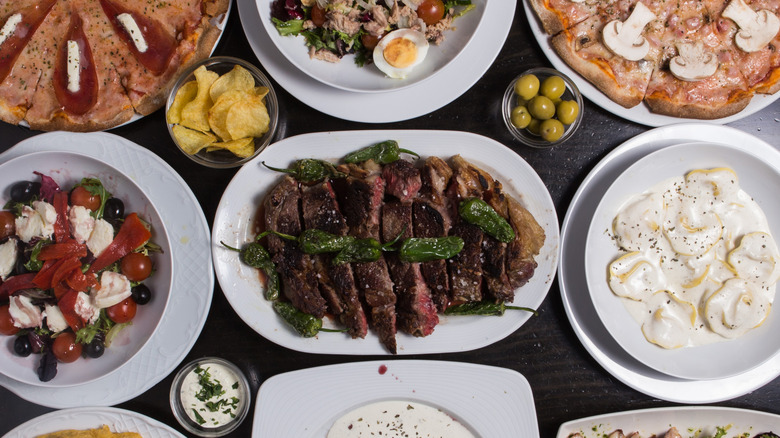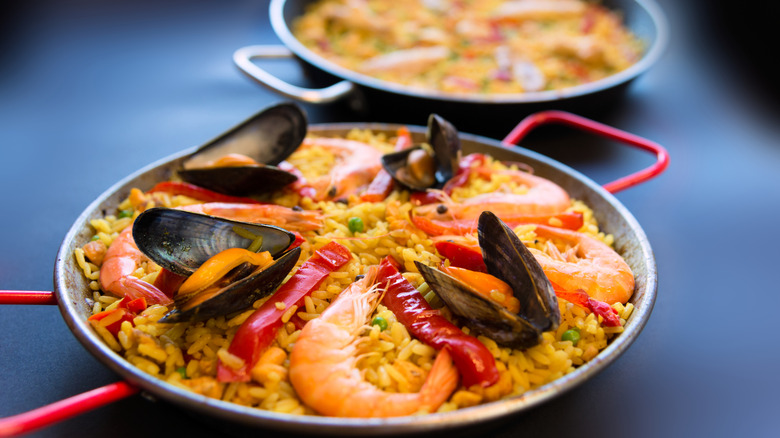The European Country That Will Serve You Free Food When You Order A Drink
In parts of southern Spain, your drink often comes with something extra, in adherence to the tradition of tapas. Around Granada and Jaén, after ordering a small beer, or a glass of local vino, you can expect a plate of food to arrive — no added costs or hidden terms included. Eastern Andalucía, in particular, holds tight to this tradition, and for many bar owners, it's a gesture of pride and a built-in welcome all folded into the price of a €2 to €3 drink (about $2.34 to $3.52, as of July 2025) .
This custom goes back centuries, with Spain's Royal Academy of Gastronomy linking the word tapa — meaning lid — to the folklore of King Alfonso X in the 13th century. While recovering from illness, he would only drink wine if it came with a small bite on top. It is said that he later told taverns to follow suit, both to keep flies and dust out of drinks and to ease the effects of alcohol. Over time, tapas grew from a simple piece of bread into a wide range of small plates.
The tradition lives on through quiet rivalry, where bars compete not just to serve, but to impress, offering everything from mini paellas to curry croquetas with each drink. Locals will move from bar to bar, comparing food at every stop. For visitors, this can also be a great way to piece together dinner — one drink at a time. It can also serve as a consolatory experience after visiting one particularly overpriced tourist trap in southern Spain.
Granada, Jaén, and Almería
Granada remains the heart of Spain's drink-and-dine culture, according to The Guardian, with offerings like grilled pork skewers, mini paellas, and thick slices of tortilla. For first-timers, Lonely Planet suggests heading to the Realejo district, where traditional taverns line the streets and every drink comes with a free bite.
In Jaén, the tapa tradition takes on a more personal touch. Here, the free bite that comes with each drink isn't just expected, it's celebrated. Travel and Tapas points out that most bars offer one tapa per round, often letting you choose from a short menu after your first drink. That simple twist can turn each stop into something more like a tasting experience.
In Almería, the free-tapa tradition is also still going strong. Order a beer, a glass of wine, or even a soda, and the bartender will bring a tapa of your choosing — like grilled octopus or vegan croquettes. Some travel guides even call Almería one of the last places in Spain where the ritual holds firm. If traveling further north on your trip, be wary, as Spain has one of the European cities you are most likely to get pickpocketed in.
Timing, tipping, and local smarts
Tapas work best when you take your time. Spain's official tourism site says the real joy is the slow bar-to-bar rhythm, one drink and one tapa before moving on. Aim for peak hours, 1 p.m. to 3 p.m. for a midday round, or 8:30 p.m. to 10:30 p.m. when the bars come alive. Stand at the counter if you can, as table service can add a charge. Before you depart, remember to avoid tipping mistakes. In fact, Culture Trip notes that service is built into Spanish wages, so tips are more of a gesture than a rule. A few coins, 20 cents here, or maybe a euro if the tapa stands out, can show your thanks without overdoing it. Drop the change under your plate or on the bar rail. Flashing big bills often feels out of place, and can signals that you're an outsider.
Also, location matters. Spain's tourism site notes that, in Andalucía, the tapa culture is still alive and well. However, in tourist-heavy areas like Madrid or Barcelona, the tradition is less likely to be in practice. Restaurants in these cities tend to sell larger plates and skip the freebies. To boost your chances of finding a tapa establishment, follow locals into side-street taverns and, above all, stay open to whatever lands on your plate.


